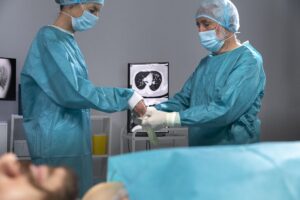Diagnostic procedures are critical in gastrointestinal health because they reveal underlying issues that may affect overall well-being. Upper Gastrointestinal (GI) endoscopy is one such critical procedure. This comprehensive guide aims to illuminate all aspects of upper GI endoscopy, from its basic purpose to its procedural complexities. Join us as we journey through the digestive tract, learning about the importance of this diagnostic tool and the expertise of specialists such as Dr. Purushottam Vashistha in its use.
What is an upper GI endoscopy?
Upper GI endoscopy, also known as esophagogastroduodenoscopy (EGD), is a key diagnostic tool for healthcare professionals. Upper GI endoscopy, also known as esophagogastroduodenoscopy (EGD), is a key diagnostic tool for healthcare professionals. This invaluable procedure allows for visual examination of the upper gastrointestinal tract. Which includes vital structures such as the esophagus, stomach, and duodenum. Medical practitioners can gain real-time insight into the inner workings of the upper digestive system, by using a thin, flexible tube equipped with a miniature camera and light source.

Does Upper GI Endoscopy Have Another Name?
Within medical circles, upper GI endoscopy and esophagogastroduodenoscopy or EGD interchangeably refer to the same procedure. This alternative nomenclature underscores the procedure’s versatility and widespread recognition among healthcare providers and patients alike.
Why Do Doctors Use UGI Endoscopy?
The utilization of upper GI endoscopy extends far beyond mere observation; it serves as a pivotal diagnostic and therapeutic modality. In the capable hands of experienced gastroenterologists like Dr. Purushottam Vashistha, this procedure becomes a gateway to uncovering a myriad of gastrointestinal anomalies, ranging from inflammation and ulcers to tumour’s and occult bleeding. Moreover, the versatility of upper GI endoscopy facilitates the procurement of tissue samples through biopsies and the implementation of therapeutic interventions, such as hemostasis for bleeding ulcers or polyp removal.
How Do I Prepare for an UGI Endoscopy?
Preparation for an upper GI endoscopy demands meticulous attention to detail and adherence to specific guidelines tailored to individual patient needs. Typically, this entails a period of fasting to ensure optimal visualization of the gastrointestinal tract, alongside the cessation of certain medications that may interfere with the procedure. Patients are also encouraged to communicate any pertinent medical history or allergies to their healthcare provider to mitigate potential complications.
How Do Doctors Perform an UGI Endoscopy?
The procedural prowess of gastroenterologists like Dr. Purushottam Vashistha comes to the fore during the execution of an UGI endoscopy. Under sedation to ensure patient comfort and cooperation, the insertion of the endoscope through the mouth initiates a journey into the depths of the digestive system. With precision and finesse, the endoscope navigates the esophagus, stomach, and duodenum, unveiling any aberrations or pathology along the way. Biopsies and therapeutic maneuvers are seamlessly integrated into the procedure, guided by the expert hands of the gastroenterologist.
What Should I Expect After an UGI Endoscopy?
Post-procedural care encompasses a period of observation as the effects of sedation gradually dissipate. Patients may experience transient throat discomfort or bloating, attributable to the insufflation of air during the procedure. Consumption of food and beverages may be temporarily restricted until deemed safe by the attending healthcare provider. Detailed post-procedural instructions, including activity restrictions and follow-up appointments, are provided to ensure optimal recovery and ongoing management of any identified conditions.
What Are Some Risks of UGI Endoscopy?
While upper GI endoscopy is renowned for its safety and efficacy, inherent risks warrant consideration and mitigation strategies. Potential complications, albeit rare, may include adverse reactions to sedation, gastrointestinal bleeding, perforation, or infection. Nonetheless, vigilant monitoring and adherence to established protocols by experienced practitioners like Dr. Purushottam Vashistha serve to minimize such risks, ensuring patient safety remains paramount throughout the procedure.
Meet Dr. Purushottam Vashistha.
Dr. Purushottam Vashistha is recognized as a gastroenterology luminary, known for his tireless commitment to patient care and clinical excellence. Dr. Vashistha, who has extensive experience and expertise in UGI endoscopy. A ray of hope for people suffering from gastrointestinal issues. His compassionate attitude and commitment to pushing the boundaries of gastroenterological care have earned him the trust and respect of both patients and colleagues.
Conclusion
To summarize, upper GI endoscopy is critical for understanding gastrointestinal pathology. This procedure has changed the landscape of gastroenterological care, beginning as a diagnostic tool, and progressing to a therapeutic instrument. Patients can tackle the complexities of UGI endoscopy with confidence if they have a thorough understanding of the procedure and collaborate with experienced professionals such as Dr. Purushottam Vashistha.
